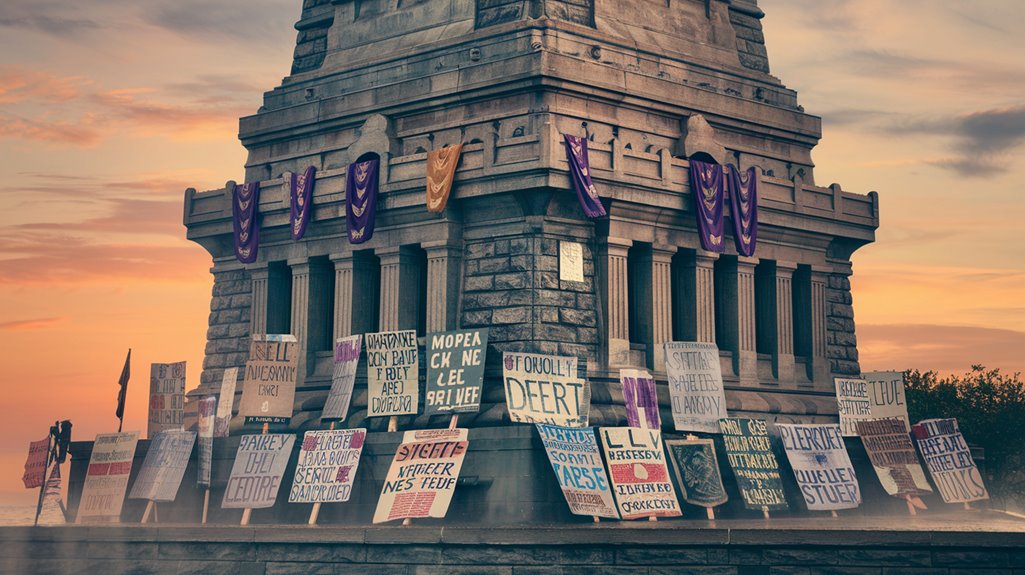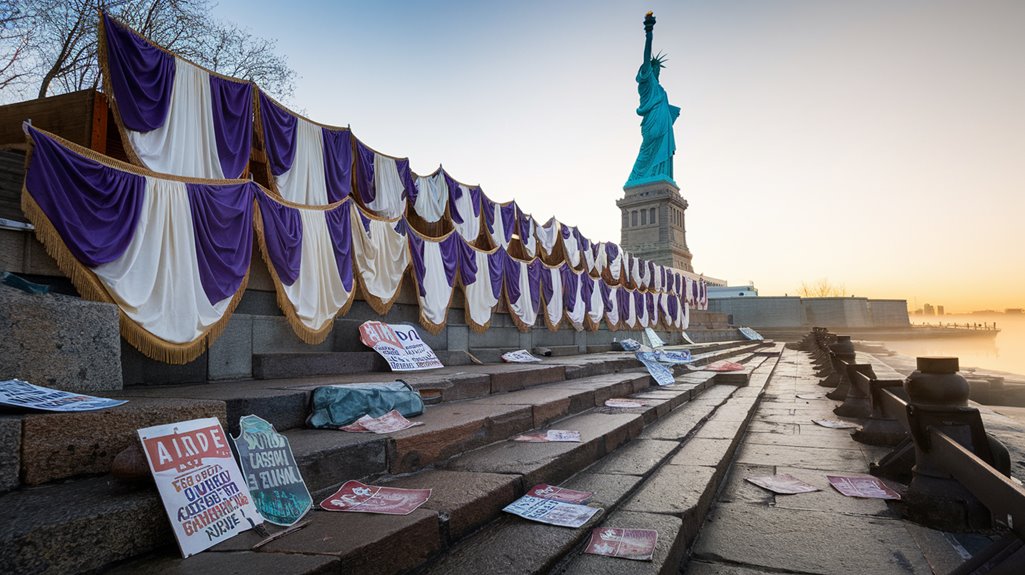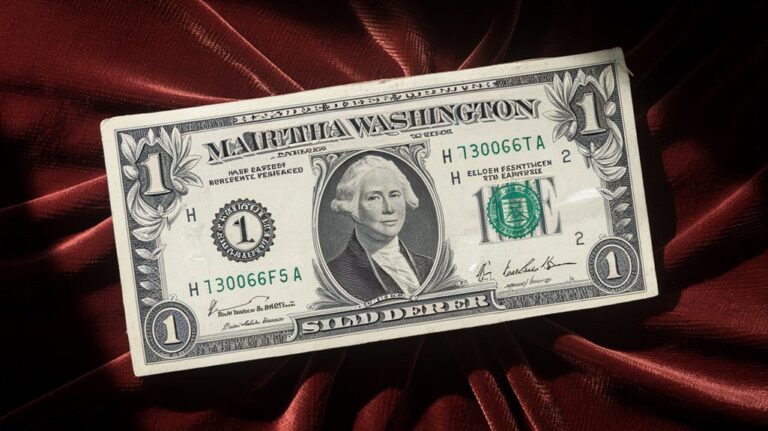Suffragists Protested the Statue of Liberty
You've seen her torch, you've admired her crown, and you've celebrated her as America's symbol of freedom – but Lady Liberty's revelation wasn't a moment of unity for everyone. While nearly a million spectators gathered to witness the statue's dedication in 1886, a bold group of suffragists staged a protest that would challenge its very meaning. Their actions on that October day didn't just highlight a glaring contradiction; they set the stage for one of the most powerful statements in women's rights history.
The Irony of Liberty's Unveiling
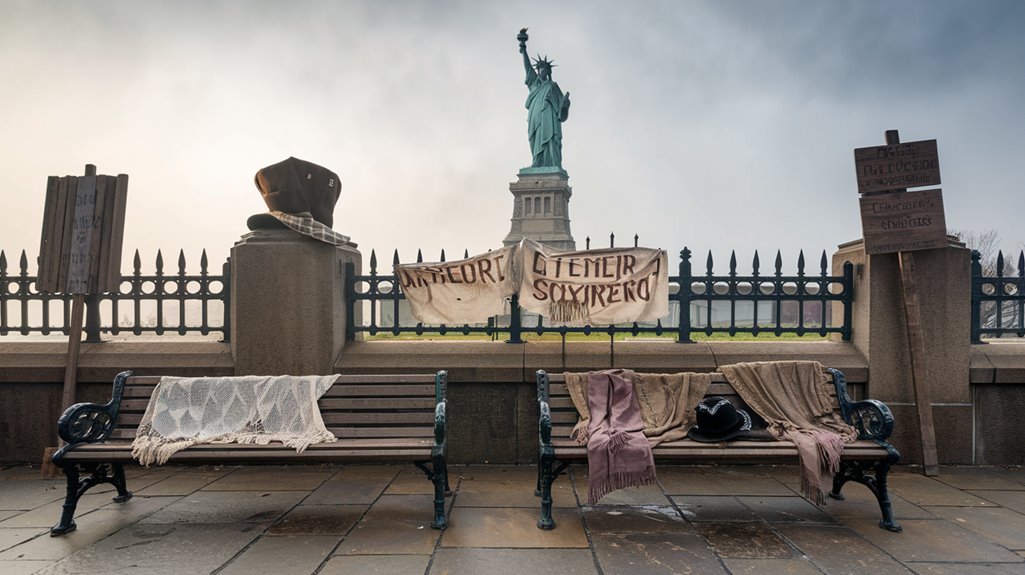
When the Statue of Liberty was presented on October 28, 1886, its ceremony disclosed a stark irony that wouldn't go unnoticed.
You'd find between 2,000 to 2,500 men at the reveal, but only two women who needed male escorts to attend. This historical symbolism of freedom, represented by a female figure, stood in sharp contrast to the reality women faced.
The societal contradictions became even more apparent when the New York State Woman Suffrage Association was denied entry for being "unaccompanied women." Led by activist Matilda Joslyn Gage, about 200 women chartered boats to protest the unveiling. The protesters displayed protest banners during the water parade, making their voices heard from the harbor.
While President Cleveland presided over the celebration of liberty, he ignored the protesting suffragists outside.
You can't miss the hypocrisy: a colossal statue of a woman representing freedom in a nation where women couldn't even vote, making the ceremony a powerful display of America's selective definition of liberty.
Women's Bold Response on the Harbor
Despite being denied entry to the official ceremony, approximately 200 determined women from the New York State Woman Suffrage Association launched their own powerful protest on New York Harbor.
You would have witnessed these suffragists employing clever strategies as they chartered a boat to circle Liberty Island.
The nautical symbolism couldn't have been more striking – while Lady Liberty stood tall with her torch, these women sailed in her shadow, carrying banners that declared "American women have no liberty."
Their protest highlighted a glaring contradiction: how could a female figure represent freedom when actual women couldn't even vote? Matilda Joslyn Gage criticized this very paradox of depicting liberty as a woman.
These "unaccompanied women," barred from the main celebration, turned their exclusion into a bold statement that caught the attention of the nearly one million onlookers gathered for the revelation.
Their determination reflected a broader movement that would grow to include 25,000 marchers in the historic Fifth Avenue demonstration of 1915.
Key Leaders Behind the Historic Protest
The masterminds behind this bold harbor protest represented some of the most influential voices in the suffrage movement.
You'll recognize Susan B. Anthony and Elizabeth Cady Stanton as the primary architects of these revolutionary suffrage strategies, while Lillie Devereux Blake played an essential role in organizing protests specifically around the Statue of Liberty.
Working through the New York State Women's Suffrage Association, these leaders developed a multi-pronged approach.
They didn't just settle for traditional demonstrations – they chartered boats to protest their exclusion from the statue's revelation and crafted powerful proclamations that exposed the hypocrisy of a female statue representing liberty while real women lacked basic rights.
President Grover Cleveland completely ignored the protesting women during the unveiling ceremony.
Their innovative tactics culminated in the dramatic 1916 biplane demonstration, where "Votes For Women!" leaflets rained down on the statue.
The legal arguments supporting women's rights found an unlikely ally in French-born lawyer Frédéric Coudert, who spoke passionately about the statue's feminine symbolism.
Media Coverage and Public Reaction
Media coverage of the suffragist protests proved surprisingly mixed, as newspapers grappled with how to portray women challenging America's newest symbol of freedom.
While some outlets featured stories highlighting the irony of a female statue representing liberty in a nation where women couldn't vote, others downplayed or ignored the demonstrations entirely.
The Statue of Liberty became a recurring symbol of racial equality struggles through art and activism in the decades that followed.
The public's reaction reflected this divide in media narratives.
You'd find both supporters and critics among the crowds, with some onlookers embracing the protesters' message while others voiced strong opposition.
Even President Cleveland chose to ignore the demonstrators during his dedication speech.
The protests ultimately shifted public perception of the statue, transforming it from a universally celebrated monument into a powerful symbol of unfulfilled promises for women and other marginalized groups.
Legacy and Impact on Women's Rights Movement
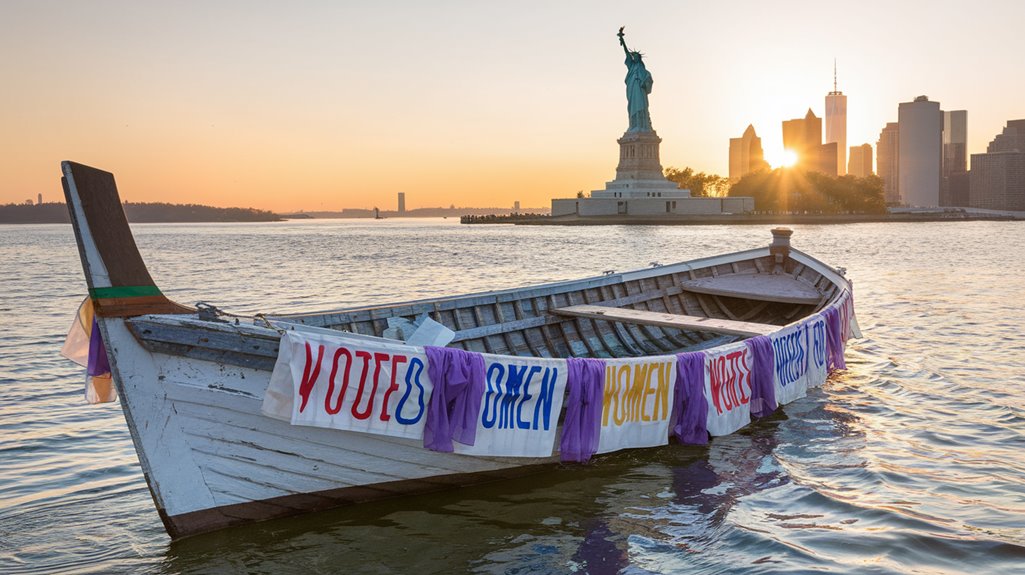
Beyond the immediate media coverage and public reaction, suffragist protests at the Statue of Liberty's revelation left an enduring mark on America's fight for women's rights.
You can see how this bold action shaped the movement's future strategies, as suffragists masterfully used symbolism to highlight the stark contrast between Lady Liberty and women's lack of political rights.
Their creative protest tactics transformed public representation of the suffrage movement, proving that women could effectively challenge societal norms through organized demonstrations. Only 6 percent of monuments in the United States honor historical women, making their fight for representation even more significant.

